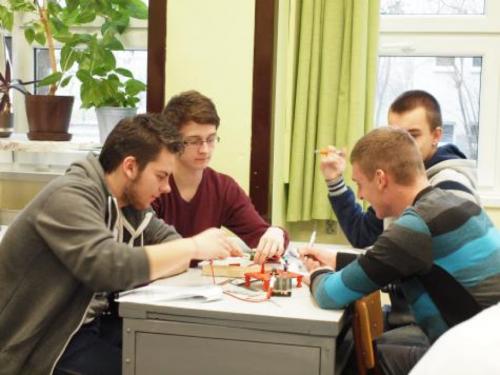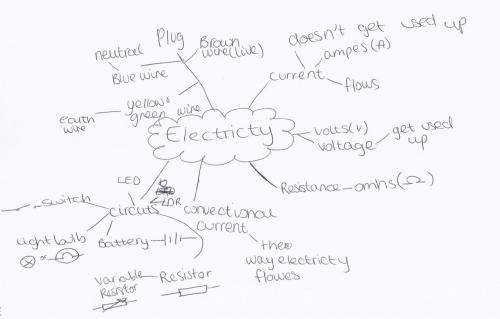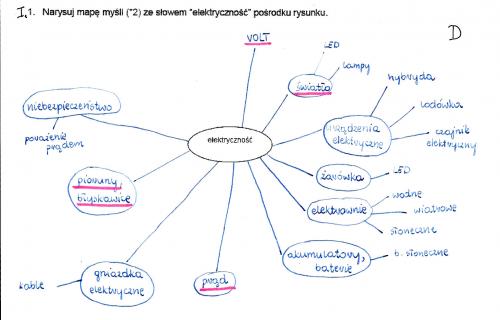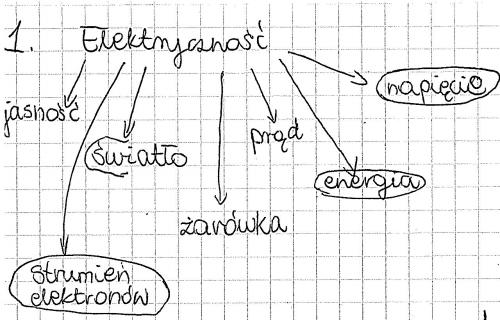The Electricity SAILS unit provides an introduction to conductivity and electric circuits and is recommended to be implemented after students have studied electrostatics. This topic is present in most of the lower second level curricula across Europe. The three activities are presented as a guided inquiry-based approach and implementation should take no more than two lessons (45 minutes each).
Activity A introduces the topic as whole class brainstorming activity, where students construct a mind map based on their prior knowledge. In Activity B, the students design and assemble a simple working electric circuit and use this circuit for planning and executing an investigation on the conductivity of every-day objects and materials (Activity C). As a further challenge, students can propose an experiment to show lightning in the classroom without the use of any device plugged into the mains. A further homework assignment is suggested, an essay on “Is electric current always dangerous to human beings?” This unit has opportunities for assessment of several inquiry skills, in particular planning investigations and working collaboratively, as well as progressing their scientific literacy and reasoning capabilities. Assessment opportunities include teacher observation, group brainstorming and student artefacts.
This unit was trialled in Slovakia, Ireland, Turkey and Poland (five case studies, 17 classes, 333 students). Planning investigation and scientific reasoning were the main skills assessed, although in Ireland working collaboratively (debating with peers) was assessed. One teacher in Turkey added an activity on developing hypotheses to the unit, and provided oral feedback to the students.
- Introduction to conductivity and electric circuits
- Simple electric circuit
- Conductivity of different materials
- Lower
- Upper
- Planning investigations
- Developing hypotheses
- Forming coherent arguments
- Working collaboratively
- Scientific reasoning
- Scientific literacy
- Classroom dialogue
- Teacher observation
- Peer-assessment
- Self-assessment
- Worksheets
- Student devised materials
- Other assessment items
The teaching and learning activities described in the Electricity SAILS inquiry and assessment unit were developed by the FP7 Fibonacci project (Fibonacci Electricity unit, http://www2.if.uj.edu.pl/fibonacci/class3.html) and adapted for use in the SAILS project by the team in Jagiellonian University. The unit comprises three activities, which are recommended for use with lower second level students, aged 12-15 years. The topic is first introduced through a whole class brainstorming activity and individual/small group construction of a mind map based on their prior knowledge (Activity A). In the second activity, the students design and assemble a simple working electric circuit (Activity B). They then use this circuit for planning and executing an investigation on the conductivity of every-day objects and materials (Activity C). Students are facilitated to improve their skills in developing hypotheses through peer discussion on the conductivity properties of these materials. Everyday contexts are included and students are facilitated to develop skills in scientific literacy and searching for information, e.g. how lightning is formed during a thunderstorm and what is the conductivity of air?
There are opportunities identified throughout this unit for the development and assessment of inquiry skills. Evidence of skill development can be collected in the form of student artefacts (worksheets or student devised materials, such as mind maps), through teacher observation or peer- and self-assessment. While some assessment tools are described within this unit, there is also flexibility for the teacher to devise and implement their own assessment instruments. Suggested skills to be assessed during implementation of this unit include developing hypotheses, planning investigations and development of scientific literacy, in particular, explaining electrical current and electrical conductivity using scientific terminology.
Below you can find the full inquiry and assessment unit for download, as well as an archive with classroom materials, including student worksheets and assessment tools for teachers to be used during the activities if available.
Unit booklet Classroom materials| Concept focus |
Connecting the concept of electricity to everyday life
|
| Inquiry skills focus |
Working collaboratively
|
| Scientific reasoning |
Making scientific connections
|
| Scientific literacy |
Explain concepts scientifically
|
| Assessment methods |
Classroom dialogue
Worksheets
Student devised materials
|
| Concept focus |
Building a simple electric circuit
|
| Inquiry skills focus |
Planning investigations
Working collaboratively
|
| Scientific reasoning |
Choosing components for electric circuit
|
| Scientific literacy |
Critiquing a method
Explaining electric current scientifically
|
| Assessment methods |
Classroom dialogue
Worksheets
|
| Concept focus |
Conductivity – conductors, insulators
|
| Inquiry skills focus |
Planning investigations
Developing hypotheses
Working collaboratively
|
| Scientific reasoning |
Making predictions
|
| Scientific literacy |
Searching for information
Explaining conductivity scientifically
|
| Assessment methods |
Worksheets
|
The Electricity SAILS inquiry and assessment unit was trialled in four countries, producing five case studies of its implementation – CS1 Slovakia, CS2 Ireland, CS3 Turkey, CS4 Poland and CS5 Poland. The case studies were conducted by 14 different science teachers in a total of 17 classes and with 333 students.
The activities have been carried out with lower second level students from mixed ability classes; CS1 Slovakia combines the classroom experiences of 10 teachers in 11 classes, CS2 Ireland reports on one teacher's implementation with two different class groups (all girls, aged 14 years) and CS4 Poland describes one teacher's implementation with one class of 14 year old students. CS3 Turkey and CS5 Poland present the experiences of teachers implementing this unit at upper second level, with students aged 15-16 years and one of the teachers in CS1 Slovakia also trialled this unit with this age group.
The key inquiry skill evaluated was planning investigations, while most case studies also reported on collecting evidence of scientific reasoning and scientific literacy. The identified assessment opportunities included students' contribution during brainstorming, students' construction of mind maps, students' abilities to draw electrical circuits and develop investigation plans. The assessment methods used include classroom dialogue, students' worksheets and other devised materials, such as mind maps, and peer-/self-assessment tools.
The inquiry approach used in all the case studies was that of guided inquiry, as outlined in the unit description. In two case studies – CS2 Ireland and CS3 Turkey – students did not have lessons on electricity prior to the implementation of this unit, while in all other classes the activities of this Electricity SAILS inquiry and assessment unit were used for revision purposes. The purpose of this unit was particularly important in student’s construction of mind maps in Activity A: Introduction to electricity. If students had no prior knowledge of the topic electricity, the mind map was used to set the everyday context. If electricity was introduced beforehand, the mind map was utilised as a revision exercise. In one class (CS2 Ireland) the mind map was used for comparison at the beginning and at the end of the unit. The unit was usually adopted as outlined, however in some cases (CS2 Ireland and CS5 Poland) the final challenge was partially or entirely skipped during the implementation.
In the Electricity SAILS inquiry and assessment unit, several assessment opportunities were identified. No one teacher that implemented this unit used all of the opportunities or tools for assessment provided, and instead they focused on particular skills for development and assessment.
Three key skills identified in the activities for teaching and learning were highlighted for assessment during implementation in the classroom. Scientific literacy and scientific reasoning about electricity could be evaluated four times – during brainstorming in activities A and C, mind maps in Activity A and using graphical and schematic representations of working electric circuits (activities B and C). The assessment of planning investigations was suggested in Activity C and could be used as a part of a group work assessment. A task involving searching for information was proposed at the end of the unit and could be offered as a homework exercise.
Below you can find the full inquiry and assessment unit for download (excluding the case studies), as well as an archive containing all the case studies.
Unit booklet Case studies| Concept focus |
Simple electric circuits
Conductivity of everyday materials
|
| Activities implemented |
Introduction to electricity
Simple electric circuits
Conductivity of different materials
|
| Inquiry skills assessed |
Planning investigations
|
| Scientific literacy |
Searching for information
Explaining lightning scientifically
|
| Assessment methods |
Classroom dialogue
Worksheets
Student devised materials
Other assessment items
|
| Level |
Lower
Upper
|
| Age |
14-16
|
| Prior experience with inquiry |
No experience
|
| Concept focus |
Introduction to electric conduction and electric circuits
Drawing electrical circuits
|
| Activities implemented |
Introduction to electricity
Simple electric circuits
Conductivity of different materials
|
| Inquiry skills assessed |
Planning investigations
Working collaboratively
|
| Scientific literacy |
Searching for information
Use of scientific language
Explaining electrical conduction scientifically
|
| Assessment methods |
Classroom dialogue
Teacher observation
Peer-assessment
Worksheets
Student devised materials
|
| Level |
Lower
|
| Age |
13-14
|
| Prior experience with inquiry |
No experience
|
| Concept focus |
Simple electric circuits
Electrical conductivity of everyday materials
|
| Activities implemented |
Introduction to electricity
Simple electric circuits
Conductivity of different materials
|
| Inquiry skills assessed |
Developing hypotheses
Forming coherent arguments
|
| Scientific literacy |
Explaining electrical conductivity scientifically
|
| Assessment methods |
Classroom dialogue
Worksheets
|
| Level |
Lower
|
| Age |
16
|
| Concept focus |
Simple electric circuits
Electrical conductivity of everyday materials
|
| Activities implemented |
Introduction to electricity
Simple electric circuits
Conductivity of different materials
|
| Inquiry skills assessed |
Planning investigations
|
| Scientific reasoning |
Identifying connections
|
| Scientific literacy |
Explaining the principles of electricity scientifically
|
| Assessment methods |
Classroom dialogue
Teacher observation
Peer-assessment
Self-assessment
Worksheets
Student devised materials
|
| Level |
Lower
|
| Age |
14
|
| Prior experience with inquiry |
No experience
|
| Concept focus |
Building working electrical circuits
Conductivity of everyday materials
|
| Activities implemented |
Introduction to electricity
Simple electric circuits
Conductivity of different materials
|
| Inquiry skills assessed |
Planning investigations
|
| Scientific reasoning |
Choosing components for an electrical circuit
|
| Scientific literacy |
Ability to explain electrical conductivity scientifically
|
| Assessment methods |
Classroom dialogue
Teacher observation
Student devised materials
|
| Level |
Upper
|
| Age |
16-17
|
| Prior experience with inquiry |
No experience
|





